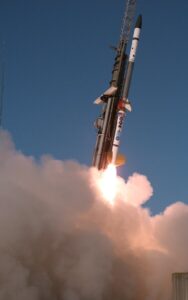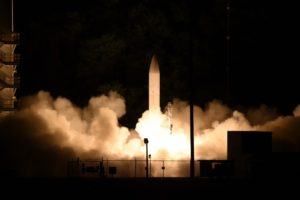The Defense Department is conducting a second flight campaign this week with hypersonic experiments to help develop hypersonic weapons and defense, the Navy said on Oct. 26.
The campaign is called the second High Operational Tempo for Hypersonics flight campaign and is being conducted by Sandia National Laboratories (SNL) from the NASA Wallops Flight Facility on Wallops Island, Va. SNL is conducting the test for both the Navy Strategic Systems Programs (SSP) and the Army Hypersonic Project Office (AHPO) to inform the Navy’s Conventional Prompt Strike (CPS) and Army Long Range Hypersonic Weapon (LRHW) offensive hypersonic weapons.

Navy SSP also noted the Missile Defense Agency (MDA) is also participating in the campaign “to gather data for its work developing systems that will defend against hypersonic weapons.”
The first flight occurred at 2:30pm EST on Oct. 26, with one precision sounding rocket that contained hypersonic experiments from CPS, MDA, AHPO, the Joint Hypersonic Transition Office, SNL, Johns Hopkins University/Applied Physics Laboratory, the MITRE Corp., Oak Ridge National Laboratory, and unspecified defense contractors.
The companies supporting the hypersonics programs include Lockheed Martin [LMT], Raytheon Technologies [RTX], Dynetics [LDOS], and General Atomics.
A second sound rocket is planned to be launched later this week to complete this campaign.
The Navy said their experimental payloads “provided data on the performance of materials and systems in a realistic hypersonic environment.”
The service underscored precision sound rocket launches are an important part of weapon system development that “fill a critical gap between ground testing and full system flight testing. These launches allow for frequent and regular flight testing opportunities to support rapid maturation of offensive and defensive hypersonic technologies.”
DoD is developing the Common Hypersonic Glide Body (C-HGB) to be used by the Army, Navy and Air Force for their hypersonic weapons, with the Army and Navy sharing the same All-Up Round that encapsulates and launches it. The Navy leads development of the C-HGB and All-Up-Round while the Army manages production.
In a statement, the Navy noted the CPS program weapon system development plan includes a set of recurring Technology Insertion points to make sure the capability improves beyond the capabilities that will be fielded in the first Army battery.
“The Technology Insertion process will allow for the routine incorporation of new capabilities and system improvements, as they become available, in order to rapidly maximize the warfighting capability delivered to our Soldiers and Sailors,” SSP said.

The Navy argued the frequency and affordability of these kinds of sounding rocket launches and flight campaigns allow the Navy and Army programs to mature the technologies before the weapon system design is finalized.
The first similar flight campaign happened about a year ago, consisting of three sounding rocket launches.
SSP said that October 2021 testing “demonstrated a capability that was deemed sufficiently mature to pursue its incorporation in the next Technology Insertion.”
It also called this week’s testing as a “vital step in the development of a Navy-designed common hypersonic missile.”
DoD also reiterated the CPS and AHPO programs are on track to support the first fielding of an operational hypersonic capability to the Army in fiscal year 2023.